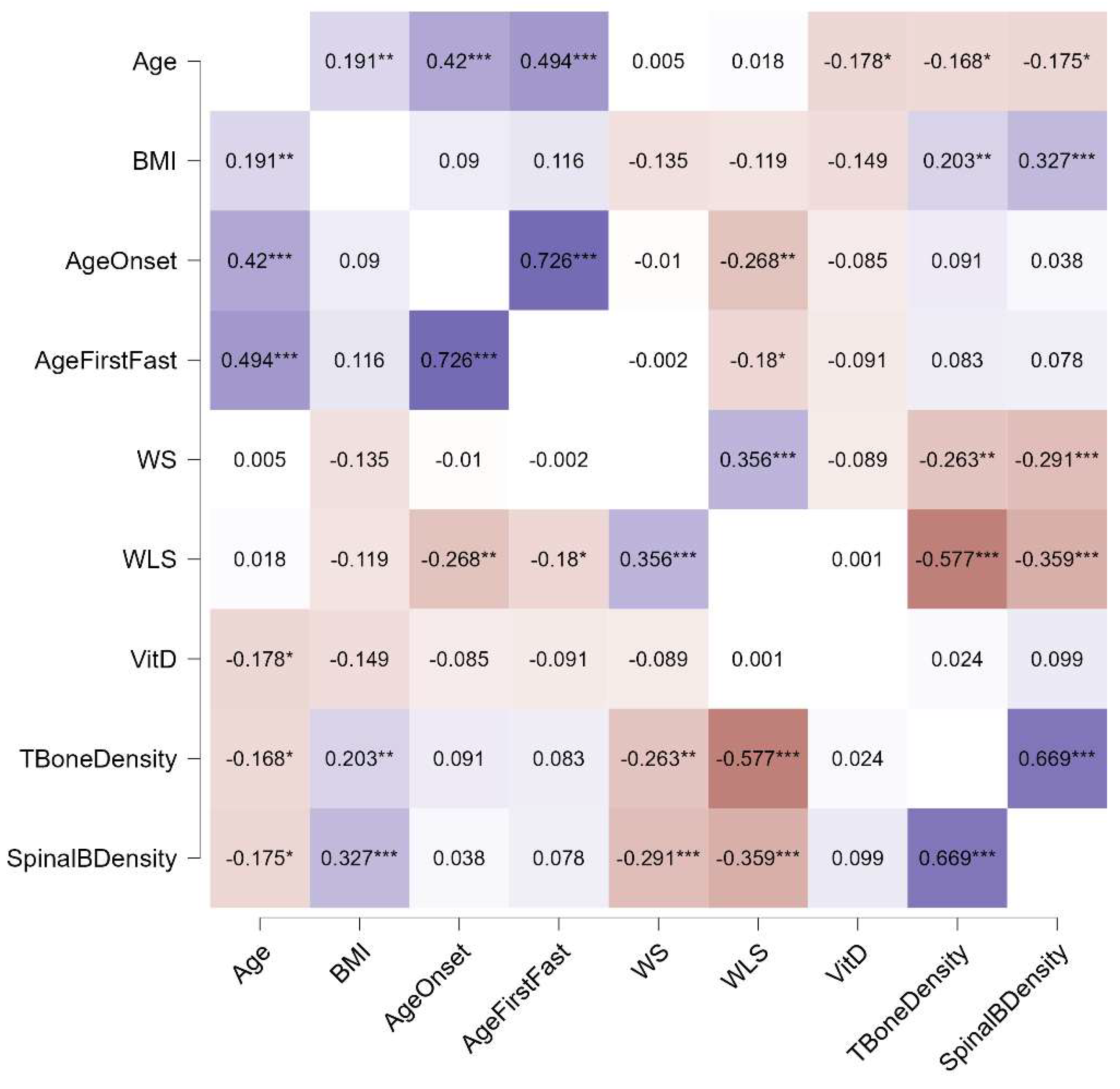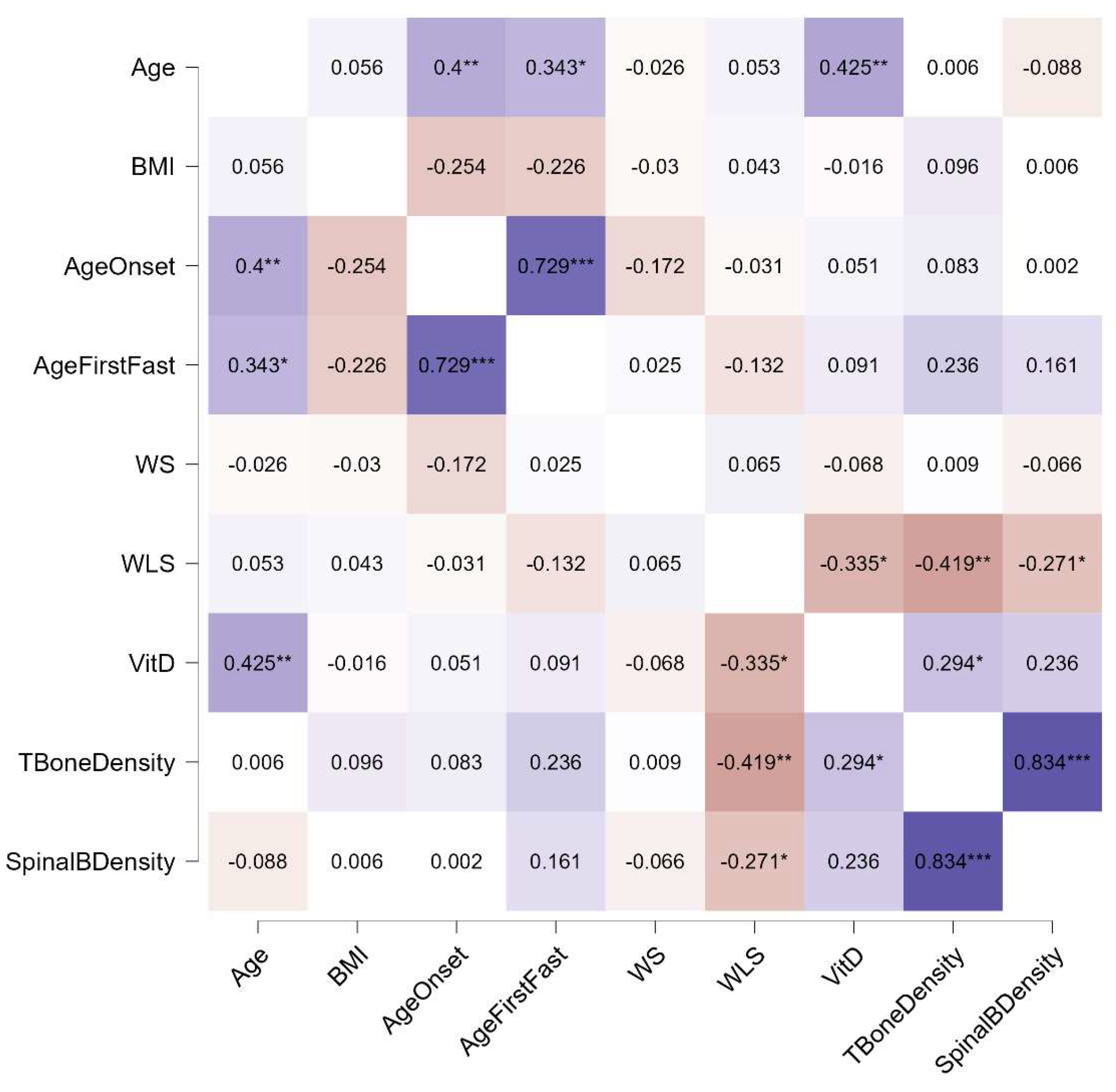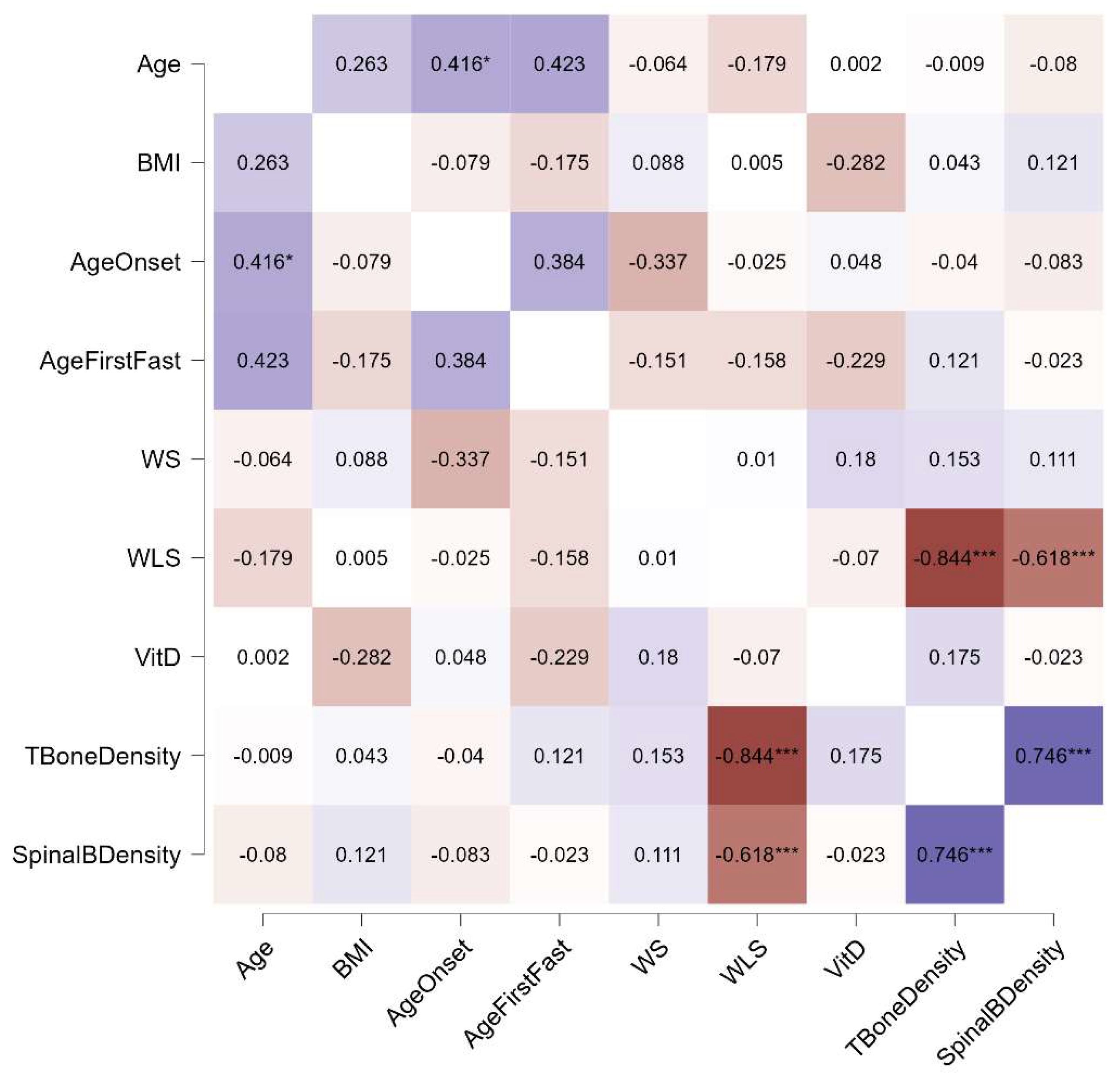Understanding Bone Density Loss in Eating Disorders: Contributions of Weight Suppression and Speed of Weight Loss
Abstract
1. Introduction
2. Materials and Methods
2.1. Participants
2.2. Measures
2.3. Statistical Plan
3. Results
3.1. Descriptive Analyses
3.2. Correlation Analyses
3.3. Regression Analyses
4. Discussion
4.1. Clinical Implications
4.2. Limitations
5. Conclusions
Author Contributions
Funding
Institutional Review Board Statement
Informed Consent Statement
Data Availability Statement
Acknowledgments
Conflicts of Interest
References
- American Psychiatric Association. Diagnostic and Statistical Manual of Mental Disorders (DSM-5); American Psychiatric Association: Arlington, VA, USA, 2013. [Google Scholar]
- Meneguzzo, P.; Todisco, P.; Calonaci, S.; Mancini, C.; Dal Brun, D.; Collantoni, E.; Donini, L.M.; Tenconi, E.; Favaro, A. Health-Related Quality of Life Assessment in Eating Disorders: Adjustment and Validation of a Specific Scale with the Inclusion of an Interpersonal Domain. Eat. Weight Disord. 2021, 26, 2251–2262. [Google Scholar] [CrossRef] [PubMed]
- Tragantzopoulou, P.; Mouratidis, C.; Paitaridou, K.; Giannouli, V. The Battle Within: A Qualitative Meta-Synthesis of the Experience of the Eating Disorder Voice. Healthcare 2024, 12, 2306. [Google Scholar] [CrossRef] [PubMed]
- Culbert, K.M.; Racine, S.E.; Klump, K.L. Research Review: What We Have Learned about the Causes of Eating Disorders—A Synthesis of Sociocultural, Psychological, and Biological Research. J. Child Psychol. Psychiatry 2015, 56, 1141–1164. [Google Scholar] [CrossRef] [PubMed]
- Meneguzzo, P.; Mancini, C.; Terlizzi, S.; Sales, C.; Francesconi, M.F.; Todisco, P. Urinary Free Cortisol and Childhood Maltreatments in Eating Disorder Patients: New Evidence for an Ecophenotype Subgroup. Eur. Eat. Disord. Rev. 2022, 30, 364–372. [Google Scholar] [CrossRef]
- Izydorczyk, B.; Sitnik-Warchulska, K. Sociocultural Appearance Standards and Risk Factors for Eating Disorders in Adolescents and Women of Various Ages. Front. Psychol. 2018, 9, 429. [Google Scholar] [CrossRef]
- Meneguzzo, P.; Dal Brun, D.; Cazzola, C.; Pillan, A.; Bonello, E.; Todisco, P. Compulsive Exercise in Eating Disorders: Validation of the Italian Scale and Evaluation of Its Relationships with Body Image Concerns and Quality of Life. Eat. Behav. 2022, 47, 101675. [Google Scholar] [CrossRef]
- Cafri, G.; Yamamiya, Y.; Brannick, M.; Thompson, J.K. The Influence of Sociocultural Factors on Body Image: A Meta-Analysis. Clin. Psychol. Sci. Pract. 2005, 12, 421. [Google Scholar] [CrossRef]
- Weissman, R.S. The Role of Sociocultural Factors in the Etiology of Eating Disorders. Psychiatr. Clin. 2019, 42, 121–144. [Google Scholar] [CrossRef]
- Meneguzzo, P.; Di Pascoli, L.; Bindolo, M.C.; Collantoni, E.; Meregalli, V.; Zanetti, T.; Veronese, A.; Tenconi, E.; Favaro, A. The Psychological and Medical Landscape of Anorexia Nervosa over a Decade: A Retrospective Study of Possible Physical and Psychological Shifts. J. Clin. Med. 2023, 12, 7294. [Google Scholar] [CrossRef]
- Mehler, P.S.; Blalock, D.V.; Walden, K.; Kaur, S.; McBride, J.; Walsh, K.; Watts, J. Medical Findings in 1,026 Consecutive Adult Inpatient–Residential Eating Disordered Patients. Int. J. Eat. Disord. 2018, 51, 305–313. [Google Scholar] [CrossRef]
- Meneguzzo, P.; Terlizzi, S.; Maggi, L.; Todisco, P. The Loneliness Factor in Eating Disorders: Implications for Psychopathology and Biological Signatures. Compr. Psychiatry 2024, 132, 152493. [Google Scholar] [CrossRef] [PubMed]
- Solmi, M.; Veronese, N.; Correll, C.U.; Favaro, A.; Santonastaso, P.; Caregaro, L.; Vancampfort, D.; Luchini, C.; De Hert, M.; Stubbs, B. Bone Mineral Density, Osteoporosis, and Fractures among People with Eating Disorders: A Systematic Review and Meta-Analysis. Acta Psychiatr. Scand. 2016, 133, 341–351. [Google Scholar] [CrossRef] [PubMed]
- Robinson, L.; Aldridge, V.; Clark, E.M.; Misra, M.; Micali, N. A Systematic Review and Meta-Analysis of the Association between Eating Disorders and Bone Density. Osteoporos. Int. 2016, 27, 1953–1966. [Google Scholar] [CrossRef] [PubMed]
- de la Rie, S.M.; van Furth, E.F.; de Koning, A.; Noordenbos, G.; Donker, M.C.H. The Quality of Life of Family Caregivers of Eating Disorder Patients. Eat. Disord. 2005, 13, 345–351. [Google Scholar] [CrossRef] [PubMed]
- Goebel, G.; Schweiger, U.; Krüger, R.; Fichter, M.M. Predictors of Bone Mineral Density in Patients with Eating Disorders. Int. J. Eat. Disord. 1999, 25, 143–150. [Google Scholar] [CrossRef]
- Solmi, M.; Gallicchio, D.; Collantoni, E.; Meneguzzo, P.; Zanetti, T.; Degortes, D.; Tenconi, E.; Bonello, E.; Veronese, A.; Ronzan, A.; et al. The Impact of Weight Suppression and Weight Loss Speed on Baseline Clinical Characteristics and Response to Treatment. Int. J. Eat. Disord. 2018, 51, 542–548. [Google Scholar] [CrossRef]
- Lowe, M.R.; Piers, A.D.; Benson, L. Weight Suppression in Eating Disorders: A Research and Conceptual Update. Curr. Psychiatry Rep. 2018, 20, 80. [Google Scholar] [CrossRef]
- Keel, P.K.; Bodell, L.P.; Forney, K.J.; Appelbaum, J.; Williams, D. Examining Weight Suppression as a Transdiagnostic Factor Influencing Illness Trajectory in Bulimic Eating Disorders. Physiol. Behav. 2019, 208, 112565. [Google Scholar] [CrossRef]
- Meneguzzo, P.; Antoniades, A.; Garolla, A.; Tozzi, F.; Todisco, P. Predictors of Psychopathology Response in Atypical Anorexia Nervosa Following Inpatient Treatment: A Propensity Score Matching Study of Weight Suppression and Weight Loss Speed. Int. J. Eat. Disord. 2024, 57, 1002–1007. [Google Scholar] [CrossRef]
- Brennan, C.; Cini, E.; Illingworth, S.; Chapman, S.; Simic, M.; Nicholls, D.; Chapman, V.; Simms, C.; Hayes, E.; Fuller, S. Greater Rate of Weight Loss Predicts Paediatric Hospital Admission in Adolescent Typical and Atypical Anorexia Nervosa. Eur. J. Pediatr. 2024, 183, 1789–1799. [Google Scholar] [CrossRef]
- Shapses, S.A.; Riedt, C.S. Bone, Body Weight, and Weight Reduction: What Are the Concerns? J. Nutr. 2006, 136, 1453–1456. [Google Scholar] [CrossRef] [PubMed]
- Enitan, S.S.; Adejumo, B.I.G.; Adejumo, E.N.; Olusanya, T.O.; Osakue, E.O.; Ladipo, O.A.; Enitan, C.B. Empowering Women to Combat Osteoporosis: Unveiling the Causes, Consequences, and Control Strategies. Aging Commun. 2023, 5, 13. [Google Scholar] [CrossRef]
- Cheng, C.H.; Chen, L.R.; Chen, K.H. Osteoporosis Due to Hormone Imbalance: An Overview of the Effects of Estrogen Deficiency and Glucocorticoid Overuse on Bone Turnover. Int. J. Mol. Sci. 2022, 23, 1376. [Google Scholar] [CrossRef] [PubMed]
- Matikainen, N.; Pekkarinen, T.; Ryhänen, E.M.; Schalin-Jäntti, C. Physiology of calcium homeostasis: An overview. Endocrinol. Metab. Clin. 2021, 50, 575–590. [Google Scholar] [CrossRef] [PubMed]
- Drabkin, A.; Rothman, M.S.; Wassenaar, E.; Mascolo, M.; Mehler, P.S. Assessment and Clinical Management of Bone Disease in Adults with Eating Disorders: A Review. J. Eat. Disord. 2017, 5, 42. [Google Scholar] [CrossRef]
- Collantoni, E.; Meneguzzo, P.; Tenconi, E.; Meregalli, V.; Manara, R.; Favaro, A. Shift Toward Randomness in Brain Networks of Patients With Anorexia Nervosa: The Role of Malnutrition. Front. Neurosci. 2021, 15, 645139. [Google Scholar] [CrossRef]
- Solmi, M.; Monaco, F.; Højlund, M.; Monteleone, A.M.; Trott, M.; Firth, J.; Carfagno, M.; Eaton, M.; De Toffol, M.; Vergine, M.; et al. Outcomes in People with Eating Disorders: A Transdiagnostic and Disorder-specific Systematic Review, Meta-analysis and Multivariable Meta-regression Analysis. World Psychiatry 2024, 23, 124–138. [Google Scholar] [CrossRef]
- Misra, M. Long-Term Skeletal Effects of Eating Disorders with Onset in Adolescence. Ann. N. Y. Acad. Sci. 2008, 1135, 212–218. [Google Scholar] [CrossRef]
- Baker, D.; Roberts, R.; Towell, T. Factors Predictive of Bone Mineral Density in Eating- Disordered Women: A Longitudinal Study. Int. J. Eat. Disord. 2000, 27, 29–35. [Google Scholar] [CrossRef]
- Zipfel, S.; Seibel, M.J.; Löwe, B.; Beumont, P.J.; Kasperk, C.; Herzog, W. Osteoporosis in Eating Disorders: A Follow-Up Study of Patients with Anorexia and Bulimia Nervosa. J. Clin. Endocrinol. Metab. 2001, 86, 5227–5233. [Google Scholar] [CrossRef]
- First, M.B.; Williams, J.B.W.; Karg, R.S.; Spitzer, R.L. Structured Clinical Interview for DSM-5® Disorders—Clinical Trials Version (SCID-5-CT); American Psychiatric Association: Arlington, VA, USA, 2015; Volume 1. [Google Scholar]
- Stice, E.; Rohde, P.; Shaw, H.; Desjardins, C. Weight Suppression Increases Odds for Future Onset of Anorexia Nervosa, Bulimia Nervosa, and Purging Disorder, but Not Binge Eating Disorder. Am. J. Clin. Nutr. 2020, 112, 941–947. [Google Scholar] [CrossRef] [PubMed]
- Bialo, S.R.; Gordon, C.M. Underweight, Overweight, and Pediatric Bone Fragility: Impact and Management. Curr. Osteoporos. Rep. 2014, 12, 319–328. [Google Scholar] [CrossRef] [PubMed]
- Beck, T.J.; Oreskovic, T.L.; Stone, K.L.; Ruff, C.B.; Ensrud, K.; Nevitt, M.C.; Genant, H.K.; Cummings, S.R. Structural Adaptation to Changing Skeletal Load in the Progression toward Hip Fragility: The Study of Osteoporotic Fractures. J. Bone Miner. Res. 2001, 16, 1108–1119. [Google Scholar] [CrossRef] [PubMed]
- Fogelholm, G.M.; Sievänen, H.T.; Kukkonen-Harjula, T.K.; Pasanen, M.E. Bone Mineral Density during Reduction, Maintenance and Regain of Body Weight in Premenopausal, Obese Women. Osteoporos. Int. 2001, 12, 199–206. [Google Scholar] [CrossRef]
- Jada, K.; Djossi, S.K.; Khedr, A.; Neupane, B.; Proskuriakova, E.; Mostafa, J.A. The Pathophysiology of Anorexia Nervosa in Hypothalamic Endocrine Function and Bone Metabolism. Cureus 2021, 13, e20548. [Google Scholar] [CrossRef]
- Fassio, A.; Idolazzi, L.; Rossini, M.; Gatti, D.; Adami, G.; Giollo, A.; Viapiana, O. The Obesity Paradox and Osteoporosis. Eat. Weight Disord. 2018, 23, 293–302. [Google Scholar] [CrossRef]
- Frølich, J.; Hansen, S.; Winkler, L.A.D.; Andresen, A.K.; Hermann, A.P.; Støving, R.K. The Role of Body Weight on Bone in Anorexia Nervosa: A HR-PQCT Study. Calcif. Tissue Int. 2017, 101, 24–33. [Google Scholar] [CrossRef]
- Jacoangeli, F.; Zoli, A.; Taranto, A.; Mezzasalma, F.S.; Ficoneri, C.; Pierangeli, S.; Menzinger, G.; Bollea, M.R. Osteoporosis and Anorexia Nervosa: Relative Role of Endocrine Alterations and Malnutrition. Eat. Weight Disord.-Stud. Anorex. Bulim. Obes. 2002, 7, 190–195. [Google Scholar] [CrossRef]
- Veronese, N.; Solmi, M.; Rizza, W.; Manzato, E.; Sergi, G.; Santonastaso, P.; Caregaro, L.; Favaro, A.; Correll, C.U. Vitamin D Status in Anorexia Nervosa: A Meta-analysis. Int. J. Eat. Disord. 2015, 48, 803–813. [Google Scholar] [CrossRef]
- Donaldson, A.A.; Gordon, C.M. Skeletal Complications of Eating Disorders. Metabolism 2015, 64, 943–951. [Google Scholar] [CrossRef]
- Jensen, V.F.H.; Mølck, A.-M.; Dalgaard, M.; McGuigan, F.E.; Akesson, K.E. Changes in Bone Mass Associated with Obesity and Weight Loss in Humans: Applicability of Animal Models. Bone 2021, 145, 115781. [Google Scholar] [CrossRef] [PubMed]
- Soltani, S.; Hunter, G.R.; Kazemi, A.; Shab-Bidar, S. The Effects of Weight Loss Approaches on Bone Mineral Density in Adults: A Systematic Review and Meta-Analysis of Randomized Controlled Trials. Osteoporos. Int. 2016, 27, 2655–2671. [Google Scholar] [CrossRef] [PubMed]
- Yung, P.; Lai, Y.M.; Tung, P.Y.; Tsui, H.T.; Wong, C.K.; Hung, V.W.Y.; Qin, L. Effects of Weight Bearing and Non-Weight Bearing Exercises on Bone Properties Using Calcaneal Quantitative Ultrasound. Br. J. Sports Med. 2005, 39, 547–551. [Google Scholar] [CrossRef] [PubMed]
- Koerner, T.; Haas, V.; Heese, J.; Karacic, M.; Ngo, E.; Correll, C.U.; Voderholzer, U.; Cuntz, U. Outcomes of an Accelerated Inpatient Refeeding Protocol in 103 Extremely Underweight Adults with Anorexia Nervosa at a Specialized Clinic in Prien, Germany. J. Clin. Med. 2020, 9, 1535. [Google Scholar] [CrossRef]
- Thorey, S.; Blanchet, C.; Guessoum, S.B.; Moro, M.R.; Ludot, M.; Carretier, E. Efficacy and Tolerance of Second-Generation Antipsychotics in Anorexia Nervosa: A Systematic Scoping Review. PLoS ONE 2023, 18, e0278189. [Google Scholar] [CrossRef]
- Voderholzer, U.; Haas, V.; Correll, C.U.; Körner, T. Medical Management of Eating Disorders: An Update. Curr. Opin. Psychiatry 2020, 33, 542–553. [Google Scholar] [CrossRef]



| AN n = 187 | BN n = 57 | BED n = 26 | H p | η2 | Post Hoc | |
|---|---|---|---|---|---|---|
| Age, years | 26.25 10.22 | 25.97 10.94 | 39.23 15.15 | 18.41 <0.001 | 0.112 | AN < BED (<0.001) BN < BED (<0.001) |
| BMI, kg/m2 | 15.21 1.86 | 21.02 1.95 | 35.48 8.33 | 176.87 <0.001 | 0.792 | AN < BN (<0.001) AN < BED (<0.001) |
| Age of onset, years | 17.53 5.97 | 16.55 5.96 | 21.00 14.25 | 2.39 0.303 | 0.025 | |
| Maximum weight, kg | 58.03 10.68 | 68.88 13.23 | 107.29 29.30 | 73.49 <0.001 | 0.526 | AN < BN (<0.001) AN < BED (<0.001) BN < BED (0.002) |
| Minimum weight, kg | 37.23 5.58 | 45.35 7.39 | 62.41 15.70 | 83.78 <0.001 | 0.514 | AN < BN (<0.001) AN < BED (<0.001) BN < BED (0.024) |
| Age of first fasting | 17.44 6.86 | 17.02 7.66 | 17.94 6.64 | 1.05 0.593 | 0.001 | |
| Weight suppression (WS), kg | 15.17 8.14 | 18.25 10.83 | 9.85 3.53 | 15.31 <0.001 | 0.526 | BED < AN (0.005) BED < BN (< 0.001) |
| Weight loss speed (WLS), kg/months | 4.28 3.75 | 3.63 2.30 | 2.61 1.67 | 5.486 0.048 | 0.514 | |
| Total Body Bone Density | −0.59 1.40 | −0.06 1.24 | 0.25 0.98 | 14.63 0.001 | 0.048 | AN < BN (0.028) AN < BED (0.004) |
| Spinal Bone Density | −1.49 1.27 | −0.53 1.25 | 0.50 1.170 | 53.78 <0.001 | 0.210 | AN < BN (<0.001) AN < BED (<0.001) BN < BED (0.013) |
| Vit. D, ng/mL | 27.86 14.66 | 25.02 10.41 | 23.43 18.34 | 7.12 0.028 | 0.013 | BED < AN (0.024) |
Disclaimer/Publisher’s Note: The statements, opinions and data contained in all publications are solely those of the individual author(s) and contributor(s) and not of MDPI and/or the editor(s). MDPI and/or the editor(s) disclaim responsibility for any injury to people or property resulting from any ideas, methods, instructions or products referred to in the content. |
© 2024 by the authors. Licensee MDPI, Basel, Switzerland. This article is an open access article distributed under the terms and conditions of the Creative Commons Attribution (CC BY) license (https://creativecommons.org/licenses/by/4.0/).
Share and Cite
Todisco, P.; Meneguzzo, P. Understanding Bone Density Loss in Eating Disorders: Contributions of Weight Suppression and Speed of Weight Loss. J. Clin. Med. 2024, 13, 7537. https://doi.org/10.3390/jcm13247537
Todisco P, Meneguzzo P. Understanding Bone Density Loss in Eating Disorders: Contributions of Weight Suppression and Speed of Weight Loss. Journal of Clinical Medicine. 2024; 13(24):7537. https://doi.org/10.3390/jcm13247537
Chicago/Turabian StyleTodisco, Patrizia, and Paolo Meneguzzo. 2024. "Understanding Bone Density Loss in Eating Disorders: Contributions of Weight Suppression and Speed of Weight Loss" Journal of Clinical Medicine 13, no. 24: 7537. https://doi.org/10.3390/jcm13247537
APA StyleTodisco, P., & Meneguzzo, P. (2024). Understanding Bone Density Loss in Eating Disorders: Contributions of Weight Suppression and Speed of Weight Loss. Journal of Clinical Medicine, 13(24), 7537. https://doi.org/10.3390/jcm13247537







